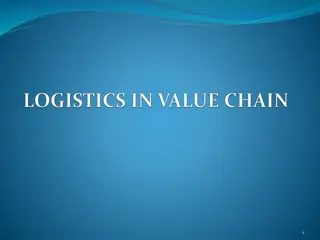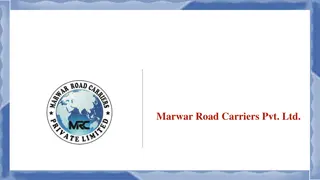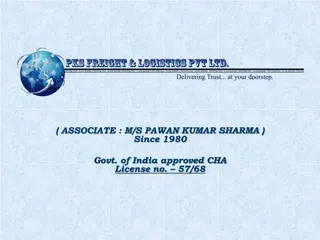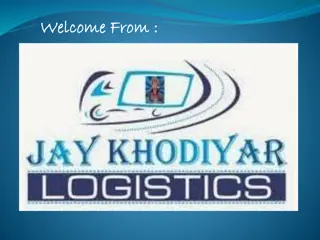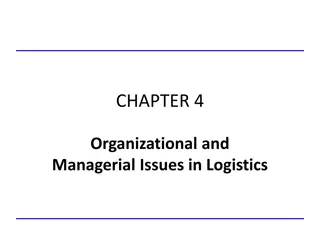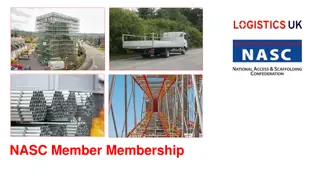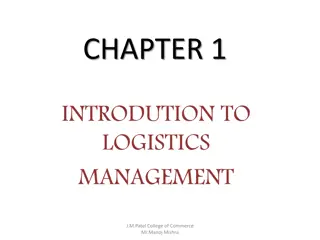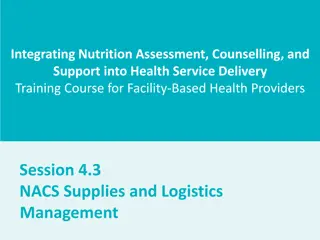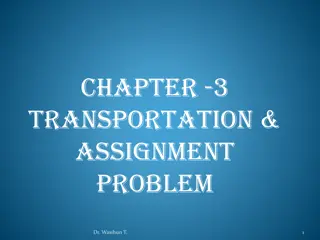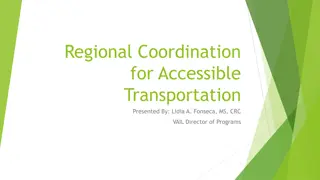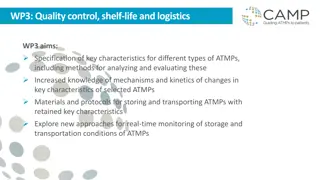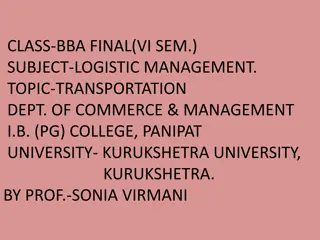Understanding Multimodal Transportation in Logistics
Multimodal transportation involves using multiple modes of transportation for logistics and freight processes. It utilizes a combination of air, road, rail, water, and package carriers to efficiently move goods. Unlike intermodal shipping, multimodal shipping allows for flexibility in handling cargo based on the carrier involved, ensuring a seamless process for shippers. International multimodal transport contracts enable the carriage of goods across different countries through various modes of transportation under a single operator, streamlining the logistics chain.
Download Presentation

Please find below an Image/Link to download the presentation.
The content on the website is provided AS IS for your information and personal use only. It may not be sold, licensed, or shared on other websites without obtaining consent from the author. Download presentation by click this link. If you encounter any issues during the download, it is possible that the publisher has removed the file from their server.
E N D
Presentation Transcript
Multi-Modal Transportation L21C27C Dr. Akshita Sharma Asst. Prof. (MSMSR) MATS University, Pandri, Raipur (C.G.) Multi- Modal Transportation L21C27C 1
MODULE I Transportation Systems & Multi modal transport- Concept of Multi modal & Intermodal Transport-introduction to Multi modal transport, the difference between Multi modal and Intermodal transport- Type of transport Modes-detail and characteristics of air, road, rail, water, pipelines, package carriers- Need, Aim and Key Issues of Multi modal transport. 2 Multi- Modal Transportation L21C27C
Transportation Systems & Multi modal transport Multimodal transportation or multimodal shipping refers to logistics and freight processes that require multiple modes of transportation. For example, one shipment may involve rail carriers, air cargo freight, as well as a truck carrier. These are three modes of transport used in combination to complete a shipment. 3 Multi- Modal Transportation L21C27C
Transportation Systems & Multi modal transport Multimodal transport is handled by a single carrier aka a multimodal transport operator or provider. The provider relies on a network of smaller carriers or contractors to do the job, but it's still a single-contract process for the shipper opting for multimodal transport. Unlike intermodal shipping, multimodal shipping allows for the cargo to be handled differently depending on the responsible carrier. E.g. the freight will be moved from a container to the pallets in a truck because of multimodal transport constraints. 4 Multi- Modal Transportation L21C27C
Concept of Multi Modal International multimodal transport means the carriage of goods by at least two different modes of transport on the basis of a multimodal transport contract from a place in one country at which the goods are taken in charge by the multimodal transport operator to a place designated for delivery situated in a different country . The operations of pick-up and delivery of goods carried out in the performance of a unimodal transport contract, as defined in such contract, shall not be considered as international multimodal transport. Multi- Modal Transportation L21C27C 5
Concept of Multimodal Transport Concept of Multimodal Transport in ASEAN and International Context: 1.International Transport 2.At least mode of transportation 3.One Operator 4.Single Transport Document and Contract of Carriage. 6 Multi- Modal Transportation L21C27C
Common understanding of difference between Intermodal and Multimodal Single transport document (multimodal contract) covering the whole carriage by several modes of transport Multimodal transport Goods remain in the same transport unit (container or road vehicles) during the entire carriage by several mode of transport Intermodal transport 7 Multi- Modal Transportation L21C27C
Advantage of Multimodal Transport 1. Reduce Complication of Liability of Intermodal Transport. 2. Dealing with one operator for contract of carriage. 3. Fix the limitation of liability of operator 4. One single contract of carriage for entire routes 5. Door-to-Door Deliverable 8 Multi- Modal Transportation L21C27C
Advantage of Multimodal Transport 6. National Wealth as Hub of Transit 7. Reduction in the costs and time for coordination and operation of logistics. 8. Increased monitoring of shipments from stage to stage. 9. There is only one company in charge of meeting the shipment deadline; therefore, there is better control on management and less risk of merchandise theft or loss while responsibility lies on just one entity. 10. Scheduling routes, costs, staff, and logistics becomes easier. 11. The FBL document has preference to enter and go through customs. 9 Multi- Modal Transportation L21C27C
Disadvantage of Multimodal Transport 1. The merchandise may encounter legal and operational limitations when international standards are applied. 2. For safety reasons, inspections in terminals are frequent, which limits 10 Multi- Modal Transportation L21C27C
What is Intermodal Transport? Intermodal Transport definition by OECD (Organisation for Economic Co-operation and Development) - Movement of goods (in one and the same loading unit or a vehicle) by successive modes of transport without handling of the goods themselves when changing modes. Intermodal Transport definition by ASEAN Training Material- The Carriage of Goods by MORE than TWO modes of transport without any handling of the freight when changing the modes through an intermodal transport chain with one single contract of carrier. In USA so called Containerized Rail Transport 11 Multi- Modal Transportation L21C27C
What is Intermodal Transport ? Intermodal Transport definition byEU Commission Intermodality1977- A characteristic of transport system that allows at least two different modes to be used in an integrated manner in a door-to-door chain . Intermodal Transport definition by European Conference of MTO (ECMT)2003 (same as OECD) The movement of goods in one and the same load unit or vehicle by successive modes of transport without handling of the goods 12 Multi- Modal Transportation L21C27C
Concept of Intermodal Transport 1. International Transport 2. At least two modes of transport 3. No handling the goods when changing modes Several Contracts of Carriage (traditional concept) Single Contract of Carriage but liability of carrier is based on each leg Multi- Modal Transportation L21C27C 13
Intermodal Transport Advantage 1. 2. 3. Increased ability to negotiate terms per stage or stretch of the route. Each supplier is responsible for its service. Possibility to choose carriers and take advantage of the best rates for each stage or stretch of the route. Fewer inspections because containers are sealed in advance. Because everything is loaded in the same container, the time it takes for loading and unloading is lower. Increased flexibility and special handling of loading and unloading in different ports. Cheaper insurance premiums. Consistent Capacity and service such as Rail and truck Quality Service because choice of selection Multi- Modal Transportation L21C27C 4. 5. 6. 7. 8. 9. 14
Intermodal Transport Disadvantage 1. Slower because cost reduction is prioritized. 2. Less reliability because there are several suppliers answering for their own services. 3. Tracking all the suppliers and coordinating solutions to delays with them. 4. More expenditures due to the need to coordinate several contracts with different suppliers. 5. The infrastructure that makes intermodal transportation easier for example, cranes for containers, is scarce and more expensive. 6. Additional packaging costs to mitigate damage when moving merchandise. 15 Multi- Modal Transportation L21C27C
What is the Difference Between Intermodal And Multimodal Transportation? Contract- Intermodal transportation sees each mode of transportation as a different contract. On the other hand, multimodal transportation maintains higher efficiency as the entire process comes under the monitoring radar of one single carrier. Thus, under intermodal, the product or container s responsibility moves from one hand to other, making it challenging to maintain strict control over quality. On the other hand, multimodal has the advantage of keeping the freight under control. Creating a unified ticketing system is more accessible with multimodal transportation. However, the passengers have to take care of individual ticket purchases for each stage of transit. 16 Multi- Modal Transportation L21C27C
Difference Between Intermodal And Multimodal Transportation. Flexibility- Intermodal transportation allows the passenger or carrier contractor to choose the best of each mode of transportation. For instance, he can choose the fastest ferry service to save hours in transit and comfortable road transportation over public transportation. In multimodal transportation, the entire process is the choice or model provided to the contractor or passenger based on the service provider s model. Delay and Overhead- In terms of overhead and delay, the contractor should keep track of every delay and complications, in each transportation mode. For instance, if an individual is traveling from airport to a remote region, he has to take into account the delay in train arrival, match it up with boarding public road transportation, and so on. One mode of transportation will not have complete information about the complications and delays in another, which leads to incoherence in intermodal transport. However, in terms of multimodal, the entire process is under the control of one service provider, which gives ease to the contractor or service user. 17 Multi- Modal Transportation L21C27C
Difference Between Intermodal And Multimodal Transportation. Cost- Intermodal transportation deals with a new contract for every mode of transportation, which increases the overall cost of transportation for the contractor or passengers. In the case of multimodal transportation, the operation cost of setting up such a service is high, but the overall package for the user can be cost-efficient than intermodal. Multimodal transportation gives better routing efficiency than intermodal transportation. Government Regulation- In case of both the origin and destination located in the same country, there isn t a considerable difference in regulations of intermodal and multimodal transportation. Let s say both points (origin and destination) are on different continents, the shipment company has to create a contract that covers the regulations of both the governments. While dealing with international transportation, the regulations ratified on the process by each country is different. This difference increases the complexity of the contract of multimodal transportation. Some countries do not have the infrastructure to implement multimodal transportation. In such cases, intermodal transportation is the best option. 18 Multi- Modal Transportation L21C27C
Difference Between Intermodal And Multimodal Transportation. Reliability / Insurance / Claims- At each node, the carrier provides a contract of lading, which shifts the responsibility of the cargo or transportation to the next service provider, in the case of intermodal transportation. Thus, during cargo claimants, the process can become complicated and tangled into webs of conditions. The claim process can vary based on the type of bill of lading provided by each carrier service provider. Depending upon the contractual conditions and agreements, the claimant s position will vary. In the case of multimodal transportation, one contract stands valid, and the service provider is claimable in case of any misfortunate events. Insurance- In the case of multimodal transportation, single umbrella insurance covers every mode of transportation. The intermodal transportation increases the overall cost of operation by requiring different types of insurance for each contract. However, this individual insurance can provide better safety and security of transportation for those transporting fragile or perishable products. The overall insurance concept is quite applicable while choosing multimodal public transportation for an area or city. 19 Multi- Modal Transportation L21C27C
Difference Between Intermodal And Multimodal Transportation. Speed vs. Cost- Multimodal transportation and intermodal transportation are both efficient in terms of speed and value when compared to conventional trucking logistics. However, in an in-depth analysis of intermodal vs multimodal concepts, multimodal transportation is the best when commuters put more emphasis on speed than the cost of transportation. This reason is why multimodal transportation is the best replacement for the public transportation system. In terms of intermodal transportation, it is cost-efficient, but the pressure and complexity of intermodal routing and creating a combination of transportation modes fall on the head of the contractor or traveler, which can become a daunting process if used daily. 20 Multi- Modal Transportation L21C27C
Mode of transport It is a term used to distinguish between different ways of transportation or transporting people or goods. The different modes of transport are air, water, and land transport, which includes rails or railways, road and off-road transport. Other modes also exist, including pipelines, cable transport, and space transport. Human- powered transport and animal-powered transport are sometimes regarded as their own mode, but never fall into the other categories. In general, transportation is used for moving of people, animals, and other goods from one place to another. Means of transport, on the other hand, refers to the transport facilities used to carry people or cargo according to the chosen mode (animal, vehicle, car, airplane, ship, truck, train and so on and so forth). Each mode of transport has a fundamentally different technological solution, and some require a separate environment. Each mode has its own infrastructure, vehicles, transport operators and operations. Multi- Modal Transportation L21C27C 21
Air Afixed-wing aircraft, typically airplane, is a heavier-than-air flying vehicle, in which the special geometry of the wings generates lift and then lifts the whole vehicle. Fixed-wing aircraft range from small trainers and recreational aircraft to large airliners and military cargo aircraft. For short distances or in places without runways, helicopters can be operable.(Other types of aircraft, like autogyros and airships, are not a significant portion of air transport.) Air transport is the fastest method of transport, Commercial jets reach speeds of up to 955 kilometers per hour (593 mph) and a considerably higher ground speed if there is a jet stream tailwind, while piston- powered general aviation aircraft may reach up to 555 kilometers per hour (345 mph) or more. Multi- Modal Transportation L21C27C 22
Air This celerity comes with higher cost and energy use, and aviation's impacts to the environment and particularly the global climate require consideration when comparing modes of transportation. The Intergovernmental Panel on Climate Change (IPCC) estimates a commercial jet's flight to have some 2-4 times the effect on the climate than if the same CO2emissions were made at ground level, because of different atmospheric chemistry and radiative forcing effects at the higher altitude.U.S. airlines alone burned about 16.2 billion gallons of fuel during the twelve months between October 2013 and September 2014.WHO estimates that globally as many as 500,000 people at a time are on planes. 23 Multi- Modal Transportation L21C27C
Air The global trend has been for increasing numbers of people to travel by air, and individually to do so with increasing frequency and over longer distances, a dilemma that has the attention of climate scientists and other researchers,]the press, and the World Wide Web. The issue of impacts from frequent travel, particularly by air because of the long distances that are easily covered in one or a few days, is called hypermobility and has been a topic of research and governmental concern for many years. 24 Multi- Modal Transportation L21C27C
Rail Rail transport is a means of conveyance of passengers and goods by way of wheeled vehicles running on rail track, known as a railway or railroad. The rails are anchored perpendicular to railroad train consists of one or more connected vehicles that run on the rails. Propulsion is commonly provided by a locomotive, that hauls a series of unpowered cars, that can carry passengers or freight. The locomotive can be powered by steam, diesel or by electricity supplied by trackside systems. Alternatively, some or all the cars can be powered, known as a multiple unit. Also, a train can be powered by horses, cables, gravity, pneumatics and gas turbines. Railed vehicles move with much less friction than rubber tires on paved roads, making trains more energy efficient, though not as efficient as ships. Intercity trains are long-haul services connecting cities; modern high-speed rail is capable of speeds up to 430 km/h (270 mph), but this requires a specially built track. Regional and commuter trains feed cities from suburbs and surrounding areas, while intra-urban transport is performed by high-capacity tramways and rapid transits, often making up the backbone of a city's public transport. Freight trains traditionally used box cars, requiring manual loading and unloading of the cargo. Since the 1960s, container trains have become the dominant solution for general freight, while large quantities of bulk are transported by dedicated trains. Multi- Modal Transportation L21C27C 25
Road Bus, cars and bicycles Trams, lorries, cars, bicycles and rickshaws, 1945 A road is an identifiable route of travel, usually surfaced with gravel, asphalt or concrete, and supporting land passage by foot or by a number of vehicles. The most common road vehicle in the developed world is the automobile, a wheeled passenger vehicle that carries its own motor. As of 2002, there were 591 million automobiles worldwide. Other users of roads include motorcars, motorcycles, buses, trucks, bicycles and pedestrians, and special provisions are sometimes made for each of these. For example, the use of bus lanes give priority for public transport, and cycle lanes provide special areas of road for bicycles to use. Motorcars offer high flexibility, but are deemed with high energy and area use, and the main source of noise and air pollution in cities; buses allow for more efficient travel at the cost of reduced flexibility.Road transport by truck is often the initial and final stage of freight transport. 26 Multi- Modal Transportation L21C27C
Water Water transport is the process of transport that a watercraft, such as a bart, ship or sailboat, makes over a body of water, such as a sea, ocean, lake, canal or river. If a boat or other vessel can successfully pass through a waterway it is known as a navigable waterway. The need for buoyancy unites watercraft, and makes the hull a dominant aspect of its construction, maintenance and appearance. When a boat is floating on the water the hull of the boat is pushing aside water where the hull now is, this is known as displacement. In the 1800s, the first steamboats were developed, using a steam engine to drive a paddle wheel or propeller to move the ship. The steam was produced using wood or coal. Now, most ships have an engine using a slightly refined type of petroleum called bunker fuel. Some ships, such as submarines, use nuclear power to produce the steam. Recreational or educational craft still use wind power, while some smaller craft use internal combustion engines to drive one or more propellers, or in the case of jet boats, an inboard water jet. In shallow draft areas, hovercraft are propelled by large pusher-prop fans. Although slow, modern sea transport is a highly effective method of transporting large quantities of non-perishable goods. Commercial vessels, nearly 35,000 in number, carried 7.4 billion tons of cargo in 2007.Transport by water is significantly less costly than air transport for transcontinental shipping; short sea shipping and ferries remain viable in coastal areas. 27 Multi- Modal Transportation L21C27C
Pipelines Pipelines can refer to gathering systems (wellhead to processing facilities), transmission lines (supply areas to markets), or distribution pipelines (most commonly to transport natural gas to medium or small consumer units).Pipelines play a very critical role in the transportation process because most of the oil moves through pipelines for at least part of the route. After the crude oil is separated from natural gas, pipelines transport the oil to another carrier or directly to a refinery. Petroleum products then travel from the refinery to market by tanker, truck, railroad tank car, or pipeline. As natural gas production grows in the United States, demand for new pipeline construction has been increasing. The United States has about 300,000 miles of natural gas transmission pipelines. 28 Multi- Modal Transportation L21C27C
Pipelines Strategic planning involves determining the shortest and most economical routes where pipelines are built, the number of pumping stations and natural gas compression stations along the line, and terminal storage facilities so that oil from almost any field can be shipped to any refinery on demand.Offshore pipelines carry more risk for leaks and environmental impact than onshore pipelines, but technological advancements in pipeline material and monitoring systems have improved pipeline safety and efficiency. Standards exist for safety in the design and construction of pipelines, and are published by organizations such as the International Organization for Standardization (ISO) and the American Petroleum Institute (API). The Federal Energy Regulatory Commission (FERC) regulates the interstate transportation of natural gas and oil, and approves LNG terminals and natural gas pipelines. Before FERC was created in 1977, Interstate Commerce Commission was responsible for regulating oil and gas transportation 29 Multi- Modal Transportation L21C27C
Parcel Carriers All e-retailers rely on the major parcel carriers to handle critical last mile delivery of packages to the customer s doorstep. While most fulfillment operations use all the big parcel carriers to some degree, most favor one specific carrier that best suits the needs of their operation. If you re wondering how to determine the best parcel carrier for your ecommerce shipping needs, read on. Figuring Out the Best Parcel Carrier for Your Needs- The big-name carriers dominate the parcel space the United States Postal Service (USPS), UPS, FedEx, and DHL. Larger online sellers may also rely on a network of smaller regional carriers to supplement last-mile delivery in bigger cities. Even if you have a 3PL providing parcel shipping services on your behalf, that 3PL uses some combination of the above to get your packages into your customers hands. The services of these carriers are similar, but different enough that zeroing in on the right one for your specific requirements can enhance your customer experience and reduce parcel freight costs. 30 Multi- Modal Transportation L21C27C
Need of Multimodal Transportation Package Weight- Dimensional weight, or DIM weight, is a technique used by parcel carriers to determine the cost of shipping parcels and incentivize customers to streamline packaging size. The height, width, and length of the package are multiplied together, and the total gets divided by a set divisor to determine its DIM weight. Parcel carriers charge for actual weight or DIM weight rounded up the nearest whole pound (whichever is higher). If you move a lot of large packages, examine the current dimensional weight pricing models of each carrier to see if a particular carrier has more affordable rates for your most common parcels. It s important to note that 3PLs shipping a high volume of parcels, like Amware Fulfillment, will negotiate a more favorable DIM factor (a higher divisor) so the published rates from the carriers don t tell the whole story. For instance, a 14-pound package by DIM weight could be charged at a 10-pound rate with a favorable DIM factor applied. 31 Multi- Modal Transportation L21C27C
Need of Multimodal Transportation Let s take a look at those published carrier rates by taking a package with 16x12x10 dimensions and putting it through the dimensional weight formula of each major carrier: USPS. The USPS uses a standard DIM divisor of 166, so 16x12x10 = 1920. 1920 166 comes out to 11.57 pounds. With USPS, your parcel s DIM weight is 12 lbs. If the actual weight of your package is less than 12 lbs., you will be billed for shipping a 12-lb. package. If the actual weight is higher, you get billed for the actual package weight. In terms of DIM weight, USPS and UPS offer a more cost-effective choice for shippers of large parcels with an actual weight lower than their DIM weight, but that s only if customers set up daily pick-ups that allow them to pay Daily Rates rather than Retail Rates. In terms of actual weight, most of the private carriers have a minimum parcel weight of one pound. Shippers moving high volumes of small packages that weigh less than a pound for example, nutraceutical businesses will benefit most from a relationship with USPS so they don t get overcharged on low-weight packages. Bottom line: DIM weight is a critical factor. Don t ignore the huge savings potential of aligning with a 3PL that has negotiated a favorable DIM factor with one or more of the major parcel carriers. 32 Multi- Modal Transportation L21C27C
Need of Multimodal Transportation Transit Time- Transit time expectations weigh heavily into parcel carrier selection. Some shippers put a lot of stock into shipping times, but others may not care if the package takes a week to arrive. When determining the best parcel shipping option, you have to carefully consider your time constraints and customer expectations to determine which carrier provides the most affordable service within that window. Total Shipping Cost If you re shipping a $5 product, you can t afford a $20 shipping charge to get it to your customer in two days. Consider your service options for each carrier. For example, if your customer is within the first few shipping zones, the package will probably arrive within the two-day window even using a cheaper standard ground delivery service, versus an expedited option. Rates vary widely depending on the carrier and specific shipping service you choose. Here are some tips about each carrier s costs to inform your choice: 33 Multi- Modal Transportation L21C27C
Need of Multimodal Transportation Communication- First and foremost, we need to talk about coordination. Multimodal movement wins over intermodal movement due to much clearer communication. Talking to one carrier company or service is enough to make freight logistics complicated. Coordination with multiple carriers can decrease efficiency and lead to loading and shipment delays. Keeping the movement down to a single contract means better overall control of transit and less contracts-related work for your legal department. Accountability- Speaking of contractual obligations, a multimodal movement also means that only one agent or provider is responsible for the movement of the freight. The tricky part of managing a supply chain is tracking and holding individual shippers and suppliers accountable for delays and wasted resources. Having one agent responsible for the freight is even referred to as "door-to-door" coverage, meaning your shipment is secured by one company. A single-contract mode will save you hours of freight management and bring the operational cost down. 34 Multi- Modal Transportation L21C27C
Key Issues of Multi Modal Transport Accessibility - Unless you're shipping fragile freight or any freight across the ocean, which entails movement between ports, keeping the cargo in one container means worse access for the carriers. Meanwhile, a combination of different modes of transport means that each mode comes with its own constraints. Deadlines- Delivery is good when it's on time and in full (OTIF). Supply chain efficiency, logistics management, and customer satisfaction all depend on the shipping deadlines being met. A clear benefit of multimodal movement is that you minimize delivery delays by giving one company control over the entire freight. Door-to-door, after all, means that shippers and carrier providers are on the same page with shipments are order fulfillment. Going with multimodal shipping over intermodal shipping helps you reduce the risk of delays and keep customer satisfaction consistently high. 35 Multi- Modal Transportation L21C27C
Key Issues of Multi Modal Transport Excessive paperwork- Even though intermodal and multimodal movements are different in terms of the number of contracts you have to deal with, multimodal shipping can still be bothersome in terms of paperwork. For example, you've settled on a carrier company that handles multimodal transport for you. Your job as a shipper is done here, right? The bad news is, the company can still invoice you for different services, i.e. each leg of transportation. As you spend more and more time processing each paper invoice, the overall shipping cost keeps growing. This is a sign for the transport and logistics industry to go paperless. Challenge: paper invoices for different services individually. Solution: paperless delivery management systems that support e-sign and photo proof of delivery. Multi- Modal Transportation L21C27C 36
Key Issues of Multi Modal Transport Poor tracking & coordination In long-haul freight, tracking a single shipment can require a combination of resources even when transportation boils down to one shipper and one carrier. Even inland movement can be tricky to monitor, let alone air cargo freight and port-to-port ocean shipments. Challenge: poor tracking and the need for constant updates. Solution: track and trace as well as automatic shipment notifications. Supply chain disruptions In 2023, no shipper is immune to supply chain disruptions. The pandemic has posed many challenges to both intermodal and multimodal transport systems, and the logistics industry is still taking a blow to this day. Especially with different modes of transport involved, shippers need to have security that in reality means being prepared for supply chain disruptions and having different intermodal and multimodal solutions as alternatives. Challenge: safety concerns, disrupted service, and inflated shipping costs. Solution: switching to local suppliers and investing in local distribution networks. Multi- Modal Transportation L21C27C 37
Assignment Q.1. Differentiate between Multi modal & Inter modal Transport. Q.2. Explain about mode of transport. 38
MODULE II How to organize Multi modal transport-Role of Containerization in MMT-history, utility, types, ease of handling, cost saving-Types of Multi modal transport-combined container transport, rolling road & forwarding of trailers, RORO & LASH transportation- National Multi modal Transport Committee (NMTC) and Logistics Policy of India-key features and importance. 39 Multi- Modal Transportation L21C27C
How to organize Multi modal transport? Multimodal transportation includes walking, biking, transit, rail, cars and trucks. Multimodal transportation is the movement of people and goods on roadways, including but not limited to, motorists, transit-riders, freight- carriers bicyclists and pedestrians, including those with disabilities. 40 Multi- Modal Transportation L21C27C
How to organize Multi modal transport? Multi-modal planning refers to planning that considers various modes (walking, cycling, automobile, public transit, etc.) and connections among modes. There are several specific types of transport planning which reflect various scales and objectives: Traffic impact studies evaluate traffic impacts and mitigation strategies for a particular development or project. Local transport planning develops municipal and neighborhood transport plans. Regional transportation planning develops plans for a metropolitan region. State, provincial and national transportation planning develops plans for a large jurisdiction, to be implemented by a transportation agency. Multi- Modal Transportation L21C27C 41
How to organize Multi modal transport? Strategic transportation plans develop long-range plans, typically 20-40 years into the future. Transportation improvement plans (TIPs) or action plans identify specific projects and programs to be implemented within a few years. Corridor transportation plans identify projects and programs to be implemented on a specific corridor, such as along a particular highway, bridge or route. Mode- or area-specific transport plans identify ways to improve a particular mode (walking, cycling, public transit, etc.) or area (a campus, downtown, industrial park, etc.). 42 Multi- Modal Transportation L21C27C
How to organize Multi modal transport? A transport planning process typically includes the following steps: Monitor existing conditions. Forecast future population and employment growth, and identify major growth corridors. Identify current and projected future transport problems and needs, and various projects and strategies to address those needs. Evaluate and prioritize potential improvement projects and strategies. Develop long-range plans and short-range programs identifying specific capital projects and operational strategies. Develop a financial plan for implementing the selected projects and strategies. Multi- Modal Transportation L21C27C 43
Transport-Role of Containerization in MMT-history The history of containerization is a development that can be pinpointed to the mid-20thcentury. Pioneered by an US-based conveyance businessman Malcolm Mclean, cargo containers were fashioned in a bid to simplify the long-drawn processes involved in shipping of cargo through sea routes. The extremely lengthy processes primarily meant that the cargo had to be suitably dismantled or separated before it could be loaded into the ships. This meant that effective labor was wasted in the initial dismantling and the later assembling procedures, and huge amounts of cargo had to be sub-divided merely because of technical restrictions and there was absolutely no standardization in the entire shipping processes. 44 Multi- Modal Transportation L21C27C
Transport-Role of Containerization in MMT-history Malcolm Mclean circumvented this protracted cargo transportation issue by modifying the basic structuring of a Second World War tanker vessel. The initial cargo containers utilized in the vessel were modified as well, and were wheel- less truck-carts. The entire success of such a novel initiative however depended on whether the modified truck-carts laded with cargo could be successfully placed into the vessel and thus transported to the necessary destination. Exceeding expectations, the ingeniously devised contraption proved to be a huge success. This success meant that for the foreseeable future, shipping cargo bulk or otherwise could be carried out with the least possible problems. 45 Multi- Modal Transportation L21C27C
Salient Features of Containerization Transiting costs for the cargo to be shipped were reduced drastically on account of the elimination of the unwanted processes Large amount of cargo could be transported which meant that transporters benefited from the economies of scale The feasibility offered by shipping containers also ensured that the water navigable channels could be utilized for transiting freight internationally Development of harbor facilities also took place simultaneously once the qualitative worth of container shipping began to spread far and wide 46 Multi- Modal Transportation L21C27C
Noteworthy Development A major noteworthy development in the history of container ships was realized when major maritime organisations acknowledged the singularity that shipping containers offered to the marine domain. This acknowledgement was also marked by the establishment of set rules and regulations with respect to the sizing of the containers. In order to bring a common platform to all containers, the International StandardizingAuthority (ISO) established the following: Containers that measured 20-feet lengthwise. Such containers were soon referred to as TEUs (Twenty-foot Equivalent Units) Containers that measured 40-feet lengthwise. Such containers soon came to be referred as FEUs (Forty-foot Equivalent Units) or more commonly, as Two-TEUs Multi- Modal Transportation L21C27C 47
Detrimental Effects to the Cargo Shipping Sector Although containerization provided a breakthrough in the global shipping sector, there were several adverse effects that were felt because of the changes it wrought. The labour force that was otherwise employed in the dismantling and the assembly-line operations, prior to the development of cargo containers started to become redundant Motorized operational links meant that lesser number of labour force needed to be involved in the lading and unloading of the freight to be shipped Semi-skilled labour force and even skilled labour force, engaged in carrying out only one kind of operations at harbor facilities were also negatively impacted 48 Multi- Modal Transportation L21C27C
Present-era: Container Shipping In the over 50-years of the initiation of shipping containers into mainstream maritime freight operations, a lot of advancement has been made. Today the global cargo shipping spectrum has widened to really enormous proportions while also helping several newer shipping conglomerates and even countries to enter the fray. With the extent of containerized operations and technological developments in the same increasing almost every day, it wouldn t be wrong to say that cargo movement in the present times cannot be visualized to fruition in the absence of container shipping 49 Multi- Modal Transportation L21C27C
Utility of Multi Modal Transportation Saving Money. The leading benefit of shipping multimodal is that it can save you a ton of money if performed properly. ... Improved Communication. Multimodal shipping involves communication between multiple parties in order to keep things running smoothly. ... Faster Transit. 50 Multi- Modal Transportation L21C27C


